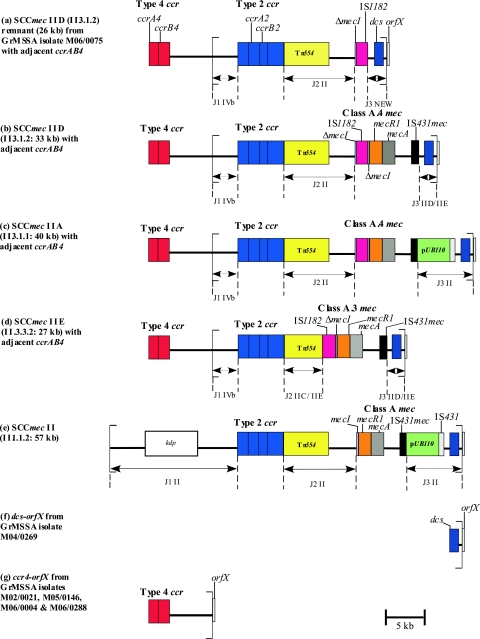FIG. 1.
Schematic diagram showing the genetic organization of the novel SCCmec IID (II.3.1.2) remnant from GrMSSA isolate M06/0075 determined in the present study (a) and the corresponding organization of SCCmec elements IID (II.3.1.2) (b), IIA (II.3.1.1) (c) IIE (II.3.3.2), (d), and II (II.1.1.2) (e), determined previously (28, 59). The structure of the SCCmec remnant from M06/0075 was determined by sequencing of the entire element (accession number AM983545) and was found to have closest similarity to SCCmec IID (II.3.1.2). The left and right extremities of the SCCmec elements/remnant are indicated with square brackets. Panels a to d also show the location of ccrAB4 identified in the present study, 5,549 bp upstream of the left chromosomal/SCCmec junction region of the SCCmec IID remnant and SCCmec elements IID (II.3.1.2), IIA (II.3.1.1), and IIE (II.3.3.2), respectively. Panel f shows the location of dcs upstream of orfX, identified in the one GrMSSA isolate (M04/0269) that yielded dcs only by SCCmec typing PCR. Panel g shows the location of ccrAB4 relative to orfX, a structure identified in the four GrMSSA isolates (M02/0021, M05/0146, M06/0004, and M06/0288) that yielded ccrAB4 only by SCCmec typing PCR. The ccrAB4 gene identified in the GrMSSA and MRSA isolates in the present study demonstrated 100% homology with ccrAB4 previously identified in the composite island SCC-CI in S. epidermidis strain ATCC 12228 (41). The DNA sequence between ccrAB4 and the SCCmec IID remnant in M06/0075 and between ccrAB4 and orfX in M02/0021 in each case was 98.5% homologous with the DNA region between ccrAB4 and SCCpbp4 in SCC-CI from S. epidermidis (accession number BK001539, bases 26100 to 24570 and bases 23009 to 18990) except that a ca. 1.5-kb contiguous DNA sequence in this region of SCC-CI (bases 24569 to 23010) was absent in M06/0075 and in M02/0021. This SCC-CI region encodes a spermidine acetyltransferase, a truncated transposase, and the type I restriction proteins HsdS and HsdR, as well as nine other hypothetical proteins (41). All of these open reading frames were also present in the DNA sequences from M06/0075 and M02/0021 referred to above, apart from the partial DNA sequence of one hypothetical protein and the complete sequence of another.

